
| Print this page - use Landscape |
Search the WeetHet Pages |
|||||||||||||||||||||||||||||||||||||||||||||||||||||||||
| WeetHet is being updated! - Current articles will slowly move to www.tweaking4all.com For excellent webhosting that is reliable and affordable, we highly recommend: LiquidWeb |
||||||||||||||||||||||||||||||||||||||||||||||||||||||||||
|
On this page...
What Is DVD? Basically, a DVD is an enhanced CDRom ... OK that's maybe a bit of a short explanation :-) After years of research, after the development of the regular CD/CDRom, a group of manufacturers and movie studios presented the so called DVD ("Digital Video Disc" or "Digital Versatile Disc") to the public in March 1997. A DVD looks pretty much like a regular CD, except for the layer reflection of the bottom layer, which is slightly more dim than the "silver" look from a commercial CD (it's very similar to the type of reflection one sees with CDRW discs, that why some older DVD players, that do not work with CDR media, do sometimes work with CDRW media). Typically, a DVD is identical in thickness (1.2 millimeters) and diameter (120 millimeters or 4.7 inches) to a standard Compact Disc, but that's where the similarities end.
Storage capacity of a single-side/single-layer DVD
is at least 7 times that of a CD. This still leaves extra room for multiple audio, language, subtitle tracks, bonus materials, interactive menu screens. Most of these are features unique to DVD (some of these features are supported by VideoCD and Super VideoCD as well). This capacity is nearly doubled (8.5 GB) on a single-side/dual-layer DVD, and quadrupled (17 GB) on a double-side/dual-layer DVD, allowing DVD to flourish not only as a movie media, but also as an amazingly flexible medium (DVD-ROM) for huge computer games, data backup and multimedia applications. Surface Basically a DVD is nothing more than a plastic (polycarbonate) disc with several layers. The diameter of a DVD is about 12 centimeters and is about 1,2 millimeter thin. If we look at a DVD from the side, for example using a microscope, we will see something similar to this picture (similar to the way a CD works):
You can store an awfull lot of data on a DVD, at least zeven times more than with a normal CD. But why are we talking about "data"? Most DVD's hold video and music isn't it, that's not the same, right? Well, information on a DVD can only be stored in a digital form, even music must be converted to digital information a.k.a. DATA. But one thing you now know: information must be digital in order to store it on a DVD. To be precise: a lot of 1's and 0's. Now you maybe can imagine what the pits (F) and bumps (E) are used for in the previous drawing. Track A different feature of a DVD is the so called Track (helix) on the disc. Basically this is the track followed by the laser and it's sensor. This works similar as the good old record-player, the needle moves through a groove (the track) until the end of the groove has been reached.
This track or helix, can be up to 12 kilometers (7.5 miles) in length for a single layer. In the above picture I simplified this, in reallity the density is much higher. Multiple layers DVD's can have multiple layers, even on both sides. In order to read the "other" side, a DVD needs to be flipped (manually).
Reading The combination of laser and sensor, the "head" (see picture below), moves from the centre of the DVD to the outside of the DVD.
In case the DVD would spin at a constant speed, the laser would come into trouble. The amount of passing pits and bumps is much greater at the outside of a DVD compared to the centre of the DVD. To get things working properly, the so called bitrate (the amount of passing bumps and pits) must be constant. To achief this, the spin-speed of a disc changes as the head moves close to the outer side of a DVD. You can compare this with running in circles. Say you have to run a circle with a particular diameter within a give time. Now try this onces more with a circle with a much larger diameter. You will notice that you must run much faster in the larger circle in order to complete the circle in the same amount of time. Basically the distance for the circle with the larger diameter is much longer, you're passing more yards. The same goes for a DVD. A DVD uses a laser, which is basically a concentrated bundle of light. One of the features of light is that it travels straight forward. Light can also be reflected, for example using a mirror. One of the rules in physics here is that, light that has been reflected, uses the same angle for both incoming and outgoing light. So, if a laser is aimed on a mirror under an angle of 45 degrees, it's reflecting will be 45 degrees as well in the opposite direction:
In the left image above, we see that the laser (A), reflects (Image 1) on the bump. The reflected laser light however does not seem to reach the sensor (B). Your DVD-player interprets this as a logical ZERO. In the second image we see a reflection on a pit (Image 2). Here we see that the reflected laser light DOES reach the sensor (B). This is being interpreted by your DVD-player as a logical ONE. Why should I bother with DVD? First of all, DVD players are pretty cheap now a days,...
even as low as $50. The improved audio and video quality of DVD, along with its durability and flexibility (no rewinding, multiple languages, etc.) makes it an ideal medium for distributing movies (for example when buying or renting a movie). Most recent DVD players come with additional cool features like MP3 playback, VideoCD and sometimes even Super VideoCD playback, allowing you to record you camcorder movies to a CD or DVD. The most recent developments bring us DVD players like the Revoy, LG and Kiss players that even playback DivX movies! New audio formats appear as well, allowing much greater audio quality, for example the Super AudioCD and the DVD Audio. However, as it becomes clear that DVD will avoid the niche-market fate of laserdiscs to become the accepted format for home entertainment, DVD - with its convenience, affordable cost, and superior performance - speaks for itself. DVD-Video: A Global Standard The DVD-Video specification was written and is now maintained by the DVD Forum working group WG1, which comprises a number of task groups concerned with both read-only and recordable/rewritable disc formats. DVD-Video is now the fastest growing consumer electronics technology of all time. Several thousand titles and millions of players are now in use around the world, with annual sales of players and discs doubling each year. DVD-Video players were launched in Japan in November 1996, in the USA in March 1997 and in Europe early 1998. Since then DVD-Video has grown faster than any other consumer electronics format in all these regions. DVD-Video has started to replace VHS as the format of choice for pre-recorded movies, both retail and rental. With the introduction of recordable versions it might also become the best replacement for high quality video recording and thus replace a VCR. DVD-Video HOLYWOOD Requirements The Hollywood based Motion Picture Studio Advisory Committee defined the following requirements for the DVD-Video format:
The Video CD format was studied, but was rejected as it could not offer the necessary combination of quality and playing time, hence the need for a new higher capacity disc format that has been realised in DVD. The above requirements have all been met in the DVD-Video specification. The DVD-Video specification is based on a pre-recorded DVD (DVD-ROM) with UDF file system. A DVD-Video can therefore be a DVD-5, DVD-10 or DVD-9 disc depending on the playing time required and other factors. For overall playing times longer than 133 minutes (including additional content), the dual layer DVD-9 offers a solution. A DVD-10 is more useful where widescreen and pan & scan versions are required on the same disc. The use of the DVD-10 format is not recommended for longer playing times, as the disc needs to be flipped to play the other side. DVD-Video discs contain video, audio and other data using a specific disc structure and directory and file structure. Within files the data are organised as data streams. Philips has in the mean while defined an additional standard called Super VideoCD, matching almost the capabilites of DVD to be found on regular CD's. DVD-Video Disc Structure DVD-Video titles consist of a hierarchical structure as illustrated below. A DVD-Video disc is divided into Video Title Sets (or titles). As a minimum there will be one Video Manager (VMG) and one VTS. A disc containing a movie plus documentary about the making of the movie is likely to be divided into two titles. A disc containing six episodes of a TV programme would be divided into six titles. However in both cases it is possible to have only one title per disc.
PGCs are used to control the playing of video, audio and subtitles in VOBs, to display menus and input and obey user commands. There are three types of PGC: sequential play, random play and shuffle play. Individual cells may be used by more than one PGC, which can define different sequences through the video content, for example to implement seamless branching. PGCs allow a command set for simple programming including mathematical and logical operators, conditional branching, countdown timer etc. DVD Files and Directories The VOBs and other data are contained in files in the VIDEO_TS directory. The table below gives an example of these files for a single title set disc.
The audio, video and subpictures for the movie are contained in up to 9 Title VOB files, where each file is not more than 1GB in size. For a DVD-5 there will be no more than 5 Title VOB files, for a DVD-9 a full 9 will be required if the disc is full. The VTS*.* files can be repeated for each VTS and will be named VTS_02*.*, VTS_03*.* etc. Each VTS will have one each of the .IFO and .BUP files plus one or more .VOB files. DVD-Video Data Streams To meet the Hollywood requirements, DVD-Video discs are designed to store audio visual sequences each comprising data streams of four types of data:
The maximum bit rate is 9.8 Mb/s for video, audio and subpictures (the overall maximum, including control information, being 10.08 Mb/s). For a playing time of 133 minutes, the average bit rate is 4.7 Mb/s. The average video bit rate available depends on the number of audio streams and the encoding used, but should be close to 4 Mb/s for high quality results. Higher bit rates are often used to give even higher video quality. To protect the copyright of Hollywood studios DVD-Video discs can be copy protected and can be region coded to play only in designated region(s). Copy protection comprises both digital and analogue methods. More details on commonly used video formats can be found on the Video Formats Page. Digital Copy Protection The Content Scrambling System (CSS) is used to scramble the audio/video data on a DVD-Video disc. Each video title set (VTS) can be selectively scrambled using a unique key. Each unique title is assigned one Disc Key and up to 99 Title Keys (one per VTS), which are stored on the disc in encrypted form. In the decoder, the original keys are obtained by decryption and used to descramble the data. Only the video data is encrypted. For DVD-ROM drives, the MPEG-2 decoder challenges the drive and receives the necessary keys for decryption. This ensures that only approved hardware/software can be used. The keys used should be unique for every disc title and are encrypted by the CSS Licensing Authority and, usually, the scrambling is carried out during glass mastering. Security is vital and the keys used plus the encryption algorithms must be kept secret. Only those companies involved in designing hardware and software for CSS encoding and/or decoding need information on the algorithms and systems used. Finding a key "unlocks" the DVDRom player. This unlocking is used when Ripping a DVD to harddisk. DVD Analogue Copy Protection The Macrovision Analogue Protection System (APS) is based on Macrovision version 7.0 and is used to distort the composite video output to prevent recording and playback on VHS. This does not extend to RGB or YUV outputs for which new methods are required and are currently being investigated. Adding APS to a DVD-Video disc requires the content owner to become licensed by Macrovision and the authoring studio to set a flag to enable APS in the player. See the MacroVision page for details. DVD Region Coding DVD-Video discs that are CSS copy protected can also be region coded to prevent e.g, a US disc playing on a European player and vice versa. This allows titles to be distributed in different parts of the world at different times. A total of six regions (or locales as they are called) have been defined to cover all countries. See the Regioncode page for more details. |
||||||||||||||||||||||||||||||||||||||||||||||||||||||||||


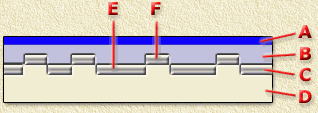
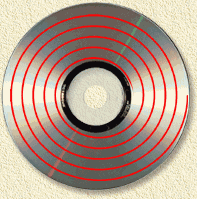
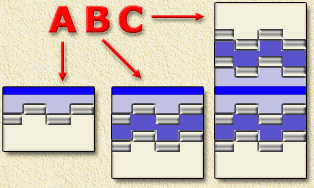
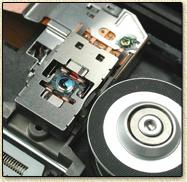
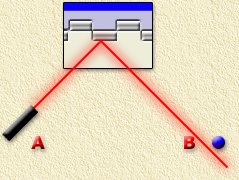
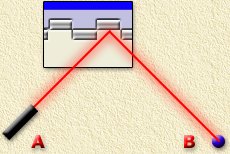
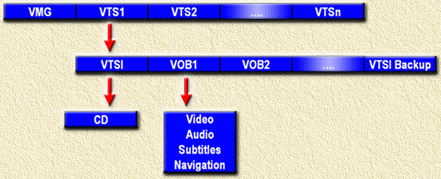 Each Video Title Set Information (VTSI)
comprises control data and Video Objects (VOB's)
for both menus (if present) and titles (stills and video). Each VOB
(the fundamental file element of the disc) comprises video, audio, subpictures
and navigation data. When a VOB is played the player
not only plays the video sequentially but obeys the navigation instructions
for displaying menus, getting user selections etc.
Each Video Title Set Information (VTSI)
comprises control data and Video Objects (VOB's)
for both menus (if present) and titles (stills and video). Each VOB
(the fundamental file element of the disc) comprises video, audio, subpictures
and navigation data. When a VOB is played the player
not only plays the video sequentially but obeys the navigation instructions
for displaying menus, getting user selections etc.